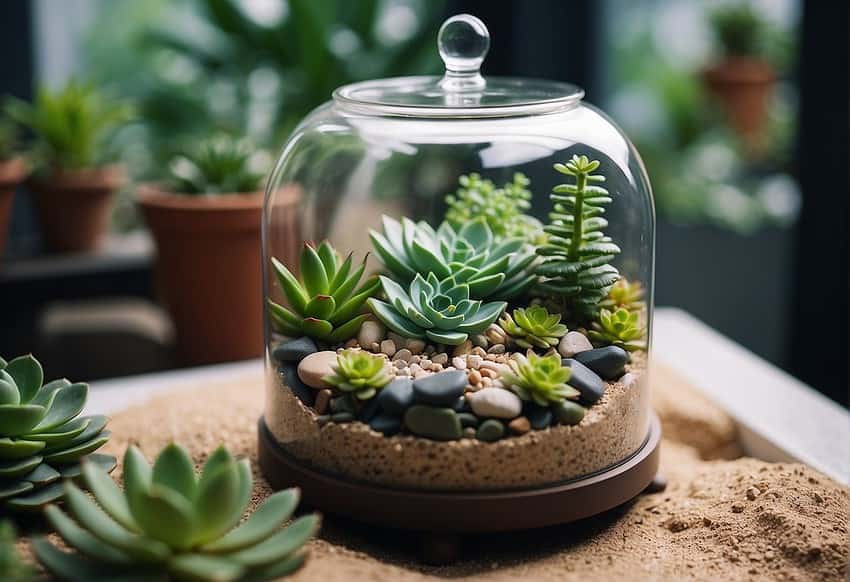A terrarium is essentially a miniature ecosystem encased in glass, offering both beauty and an educational glimpse into the delicate balance of nature. Assembling a terrarium requires understanding its different layers and how they interact to sustain plant life. The bottommost terrarium layer, often composed of small rocks or gravel, acts as the drainage layer, critical for managing excess water and mimicking a natural filtration system. This foundational component is essential for preventing root rot and ensuring the longevity of the terrarium’s lush environment.
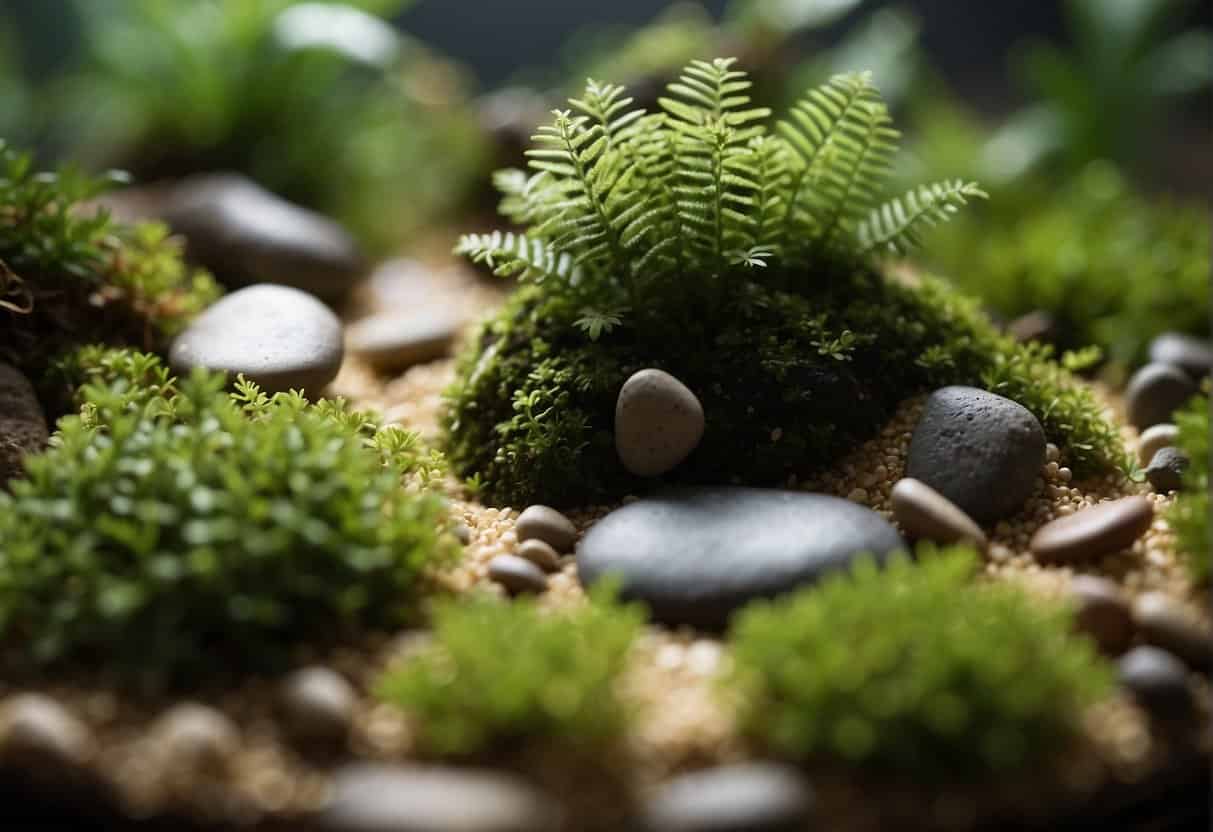
Above the drainage base, a layer of activated charcoal is typically added. Its purpose is to purify the water that trickles down and to reduce the buildup of bacterial and fungal growth, which could otherwise overwhelm the confined space. Then comes a layer of sphagnum moss, which acts as a barrier to prevent the soil from mixing into the drainage rocks, keeping the aesthetic appeal and functional stratification intact.
Finally, the soil forms the main body of the terrarium, selected carefully to match the needs of the plants being introduced. This microhabitat, when properly layered, becomes a self-sustaining ecosystem requiring minimal maintenance. The magic of a terrarium lies in its ability to recreate a piece of the natural world in a controlled, reduced space, providing an enchanting visual spectacle and a peaceful green refuge.
Understanding Terrariums
Terrariums represent intricate miniature ecosystems enclosed in various types of containers. They embody self-sustaining environments where plants and microorganisms can thrive with minimal external interference.
Defining a Terrarium
A terrarium is a self-contained, transparent container, usually made of glass, that houses a small-scale ecosystem. This ecosystem typically includes soil, plants, and sometimes small animals or insects, all thriving in a controlled, balanced environment.
Types of Terrariums
There are primarily two types of terrariums:
- Closed terrariums are entirely sealed to form a self-sustaining ecosystem through the natural cycle of water evaporation and condensation.
- Open terrariums, which are not sealed, offering a habitat for plants that require less humidity and more air circulation.
Both types are versatile and can be established in a myriad of containers, from simple jars to elaborate glass cases.
Benefits of a Miniature Ecosystem
Incorporating a terrarium into indoor spaces offers several advantages:
- Aesthetic Appeal: They add a touch of greenery and vitality to indoor spaces.
- Educational Value: They allow for observation of ecological processes on a small scale.
- Well-being: Studies suggest that exposure to greenery and involvement in its care can reduce stress levels.
By maintaining their own small water cycle and mimicking the larger processes of nature, terrarium ecosystems can flourish with little maintenance, making them ideal for both novice gardeners and plant enthusiasts alike.
Design and Planning
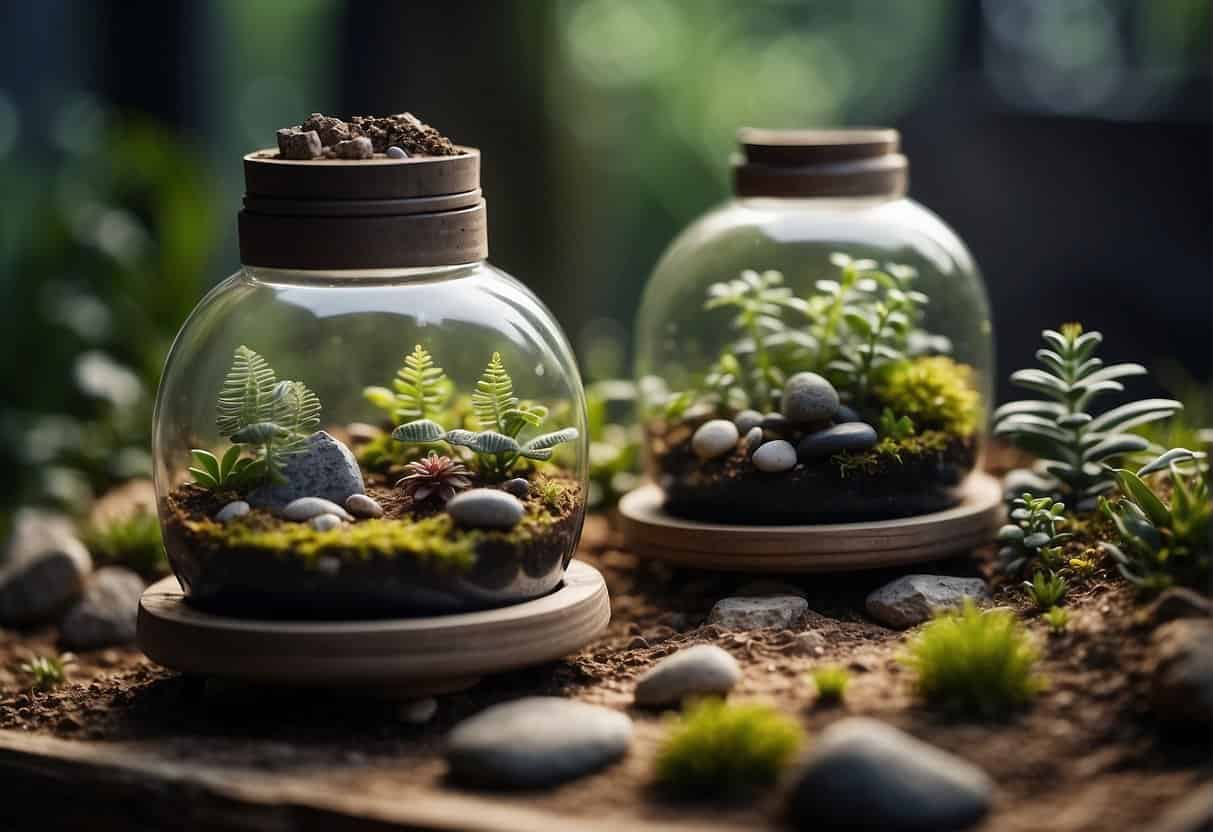
In building the perfect miniature ecosystem, careful design and planning are crucial. Selecting an appropriate container, considering size and shape, and fostering creativity inform successful terrarium creation.
Choosing the Right Container
The container is the foundation of any terrarium and influences its health and aesthetics. Glass containers are popular for their clarity, allowing unobstructed views of the terrarium layers. They should be chosen based on both the types of plants being used and where the terrarium will be displayed.
Size and Shape Considerations
The size of the container dictates the number and type of plants it can support, while the shape can affect plant growth and how water cycles through the ecosystem. Larger containers can host more diverse plant life but need more careful monitoring of humidity and soil moisture. Conversely, smaller containers are easier to manage but limit the diversity of the ecosystem.
- Small (<3 liters): Suitable for micro-plants or mosses.
- Medium (3-10 liters): Accommodates several plant species and design elements.
- Large (>10 liters): Best for advanced hobbyists looking to create complex landscapes.
Shapes can vary widely from standard orbs and cubes to more elaborate designs. This choice impacts not just the visual appeal but also the maintenance and growth patterns within the terrarium.
Themes and Creativity
Themes encapsulate the terrarium’s essence and inspire creativity, from lush tropical to arid desert landscapes. Personal expression in the design is not only enjoyable but also ensures each terrarium is unique. Integrating decorative elements, such as rocks, wood, or figurines, adds to the aesthetic value and can create a scene or narrative within the ecosystem. For instance, a step-by-step guide to building success highlights how creative layering can construct a thriving terrarium.
- Tropical Theme: Rich greens, high humidity, and vibrant flowers.
- Desert Theme: Cacti, succulents, and sandy substrates.
- Fairy Garden: Figurines, tiny houses, and delicate plants create a fantasy setting.
When planning a terrarium, it’s essential to balance the living elements with these creative touches to maintain a healthy ecosystem that is also a piece of living art.
Materials and Layers
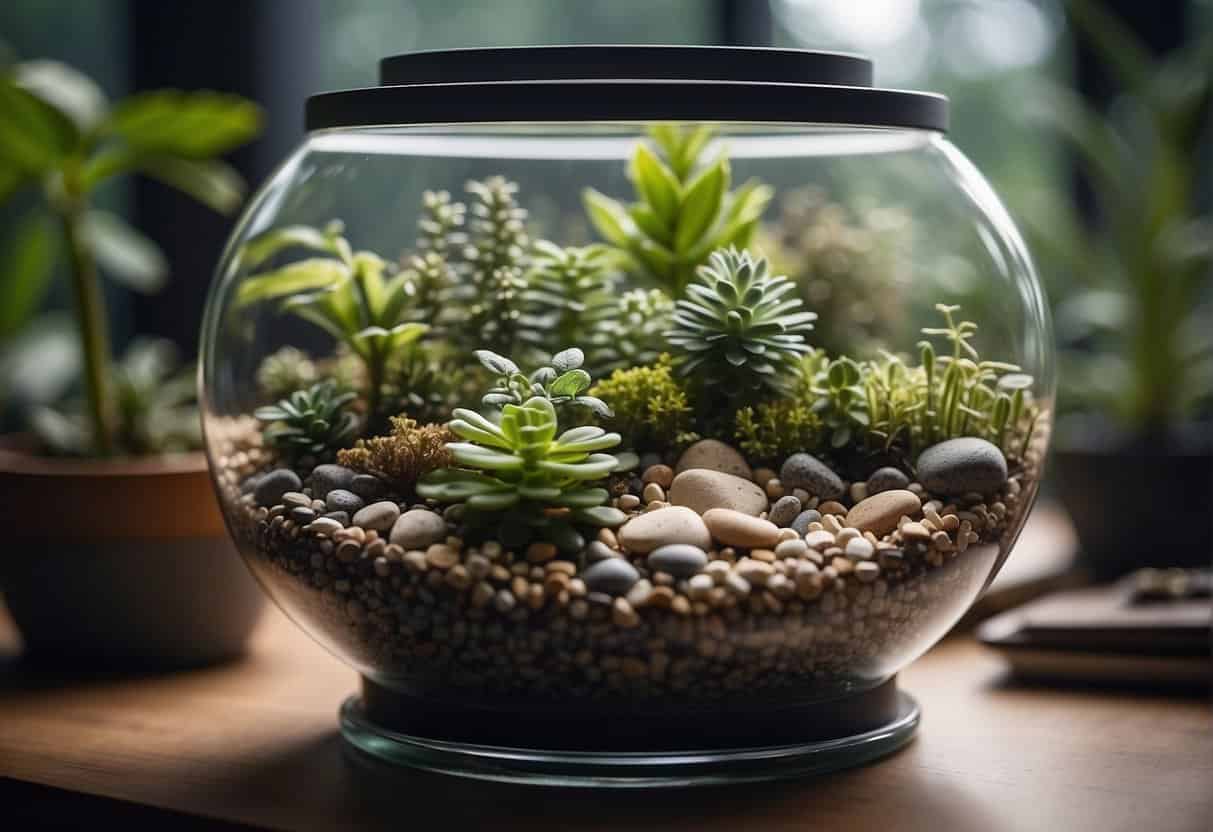
The creation of a terrarium layers the elements of the natural world in a contained environment, using specific materials to simulate a thriving ecosystem.
Overview of Terrarium Layers
The essence of a terrarium lies in its layered structure, each providing a critical function. The layers typically start with drainage, followed by a soil substrate, and are topped with plants and decorative elements, each chosen to mimic a small-scale natural habitat.
Selection of Materials
Drainage materials: Smooth stones or pebbles are often used to allow water to flow away from the plant roots. Soil substrates: A mix of potting soil tailored to your plants’ needs promotes healthy growth. Activated charcoal: A thin layer can improve the terrarium’s air quality and control odor. Sphagnum moss or sand: These may act as a separator to keep the soil layer from mixing with the drainage layer.
Creating a Drainage Layer
A drainage layer made up of gravel or LECA (Lightweight Expanded Clay Aggregates) sits at the base of the terrarium, preventing water from pooling around plant roots, which can cause rot.
Building the Substrate Layer
Above the drainage layer, potting soil is the primary medium wherein roots expand and thrive. A barrier layer of sphagnum moss can be placed between the soil and drainage layers to maintain separation. Your choice of soil mix should correspond with the types of plants you intend to use.
Choosing Plants and Decorations
Selections of plants should be based on the terrarium environment (tropical or desert) with considerations for light, humidity, and space. Incorporate hardscape items such as rocks or wood for structure and character. Finish with decorative elements such as mosses or figurines to personalize your miniature ecosystem.
Plant Selection and Care
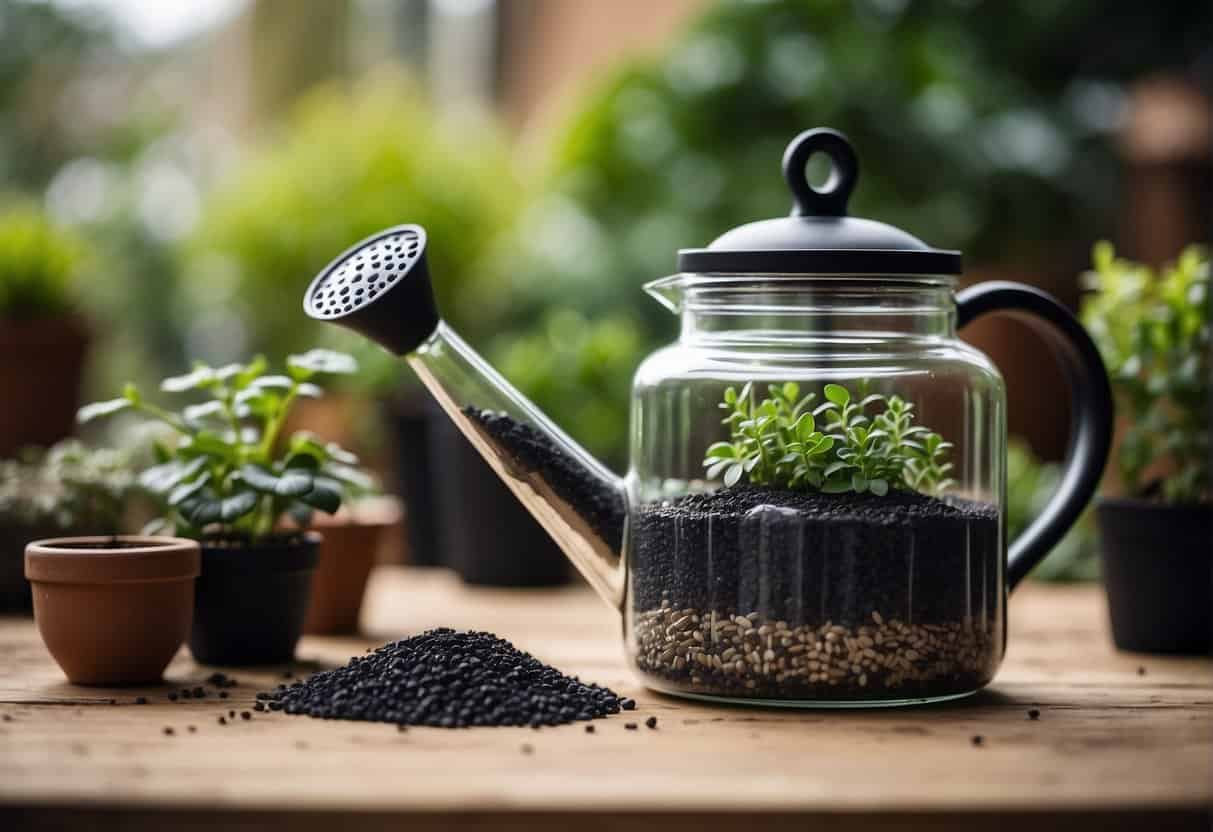
When building a terrarium, it’s crucial to select the right plants and understand how to care for them. Specific types need to be chosen that will thrive in the controlled environment of a terrarium along with proper techniques for planting and ongoing maintenance.
Best Plants for Terrariums
Terrariums create a unique environment, favoring plants that can thrive in high humidity and indirect light. Ferns and mosses are excellent choices due to their love for damp conditions and their ability to grow without deep soil. Fern varieties like the Bird’s Nest or Button Fern offer attractive foliage and adapt well to terrarium life. Succulents and air plants are suited for open terrariums with dry conditions; however, overwatering can be detrimental to these types. Succulents such as Haworthia or Echeveria present a range of textures and colors, while air plants like Tillandsia do not need soil and absorb moisture from the air.
Planting Techniques
When planting in a terrarium, ensure that the roots of the plants have enough space to establish themselves. Begin with a suitable drainage layer to prevent water from stagnating, protecting the roots from rot. Use a layer of activated charcoal to keep water fresh, followed by a layer of sphagnum moss to prevent soil from settling into the drainage area. Place the soil layer cautiously, pressing down gently around the roots and stems. When arranging the plants, consider the visual composition but also their growth habits and needs, positioning taller plants like small tropical plants or vines towards the back and smaller ones in front.
Maintenance and Care
Regular care is vital for a terrarium’s health and involves more than just watering; it’s about watching for growth changes, pruning, and ensuring proper exposure to light. For instance, ferns and tropical foliage may require periodic misting to maintain humidity, while succulents should be watered sparingly, letting the soil dry out between watering sessions. It’s important to remove any yellowing or dead leaves to prevent mold growth, and to trim back any foliage that outgrows the space. Monitoring the terrarium’s climate and adjusting care accordingly will keep the miniature ecosystem thriving.
Environmental Controls
Effective environmental controls within a terrarium are essential for maintaining a balanced ecosystem. Conditions such as light, temperature, humidity, and air quality must be managed diligently to ensure the health and longevity of the contained environment.
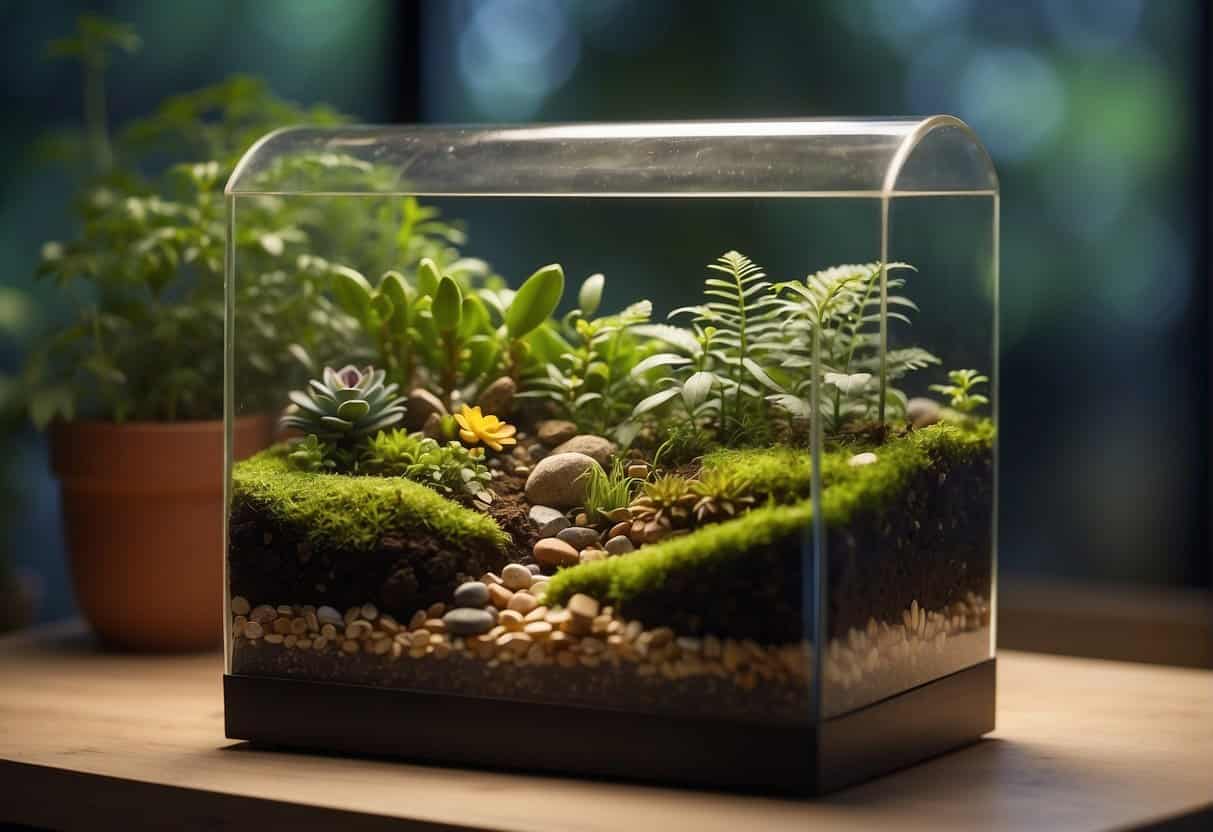
Light and Temperature
Terrariums require consistent light exposure to simulate the natural conditions plants and other inhabitants need to thrive. Direct sunlight can often be too intense, leading to overheating and harm to delicate ecosystems. It is advisable to provide bright, indirect light or use artificial grow lights that meet the light requirements of specific plants. Temperature plays a critical role, too, with most terrariums faring well in a stable range between 65°F and 75°F (18°C to 24°C).
Managing Humidity and Moisture
Humidity levels within a terrarium are sustained through the water cycle of transpiration and condensation. Watering should be minimal but sufficient to maintain high humidity without causing stagnation. Plants release moisture into the air, which then condenses on the container’s walls, illustrating an adequate level of humidity. To avoid issues like mold growth, ensure that any excess water can drain or evaporate as needed.
Air Circulation and Filtration
Good airflow is vital to prevent the accumulation of too much humidity, which can invite pests or diseases. A terrarium should have small openings or be periodically opened to exchange air and control humidity levels. Incorporating a filtration layer of activated charcoal beneath the soil can also help to purify the air and keep the ecosystem fresh, balancing high humidity with the need for clean air circulation.
Terrarium Maintenance
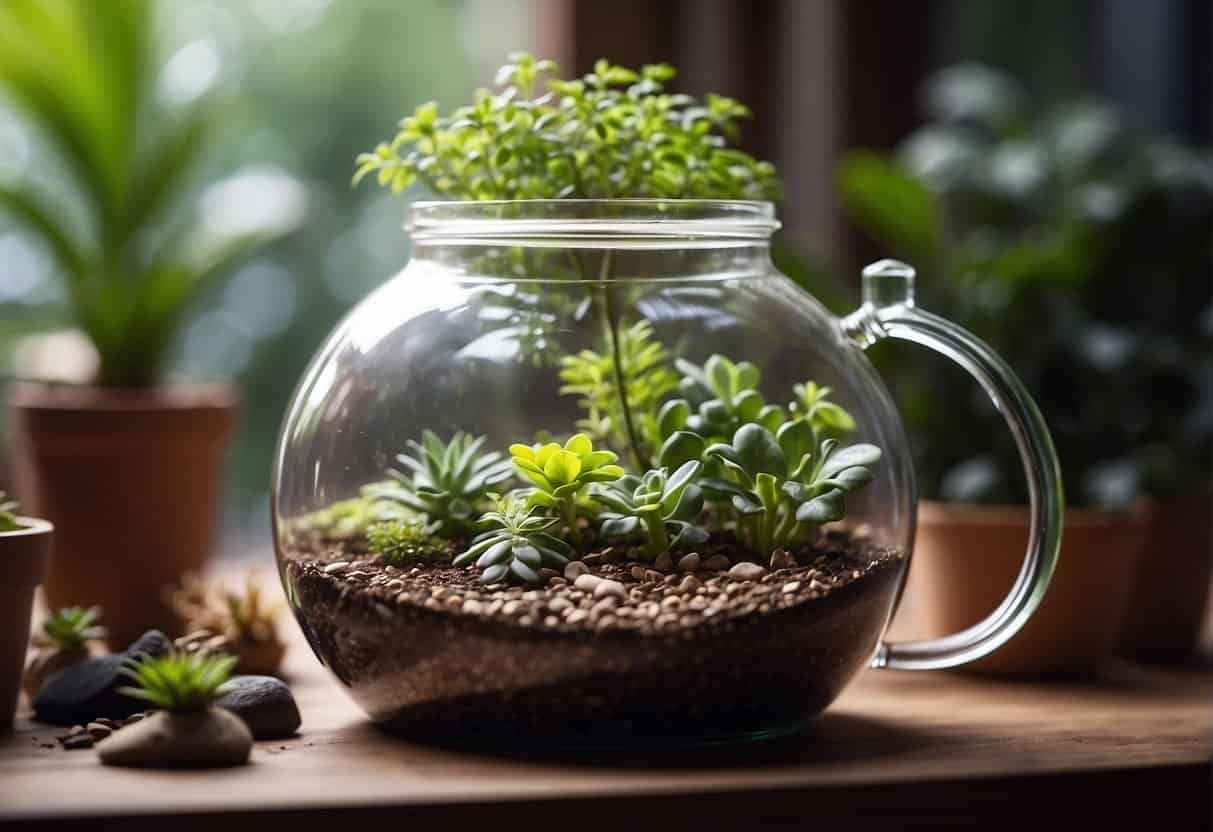
Maintaining a terrarium is crucial to ensure the sustainability and beauty of this miniature ecosystem. Proper care involves routine cleaning, monitoring humidity levels, and preventing the growth of mold and harmful bacteria.
Cleaning and Upkeep
Cleaning is essential to maintain the clarity of the terrarium glass and the overall aesthetic beauty of the miniature landscape. It is recommended to wipe the interior and exterior glass with a soft, damp cloth to remove any dirt or watermarks. For the inside, it’s vital to use a cloth that is free of chemicals to avoid harming the plants and any small inhabitants.
Upkeep also includes pruning dead or overgrown plants, removing fallen debris, and checking the foundation layers for compaction or degradation. One may need to occasionally replenish or replace the topsoil layer to sustain plant health, as over time, essential nutrients can be depleted.
Detecting and Preventing Problems
- Mold and Fungal Growth: To prevent mold, it’s important to ensure proper ventilation and balance humidity levels. Spots of white or green fuzzy appearance are telltale signs of mold, which should be removed promptly to prevent spread.
- Bacterial Overgrowth: Bacteria thrive in humid environments, so monitoring for foul odors can be key in detecting bacterial issues. Quick action in adjusting moisture levels can prevent harmful bacterial growth.
- Humidity Balance: An imbalanced humidity level can cause a slew of issues, including mold, overgrowth of algae, and unhealthy plant conditions. If there’s too much condensation, leave the terrarium open for a short while to dry out; if it’s too dry, misting the terrarium can help raise the humidity.
- Fertilizer Use: Be cautious with fertilizer application, as terrariums typically require less fertilizer than outdoor plants. Overuse can cause harm to the micro-ecosystem.
By adhering to these maintenance practices, a terrarium can remain a visually pleasing and balanced ecosystem for years to come.
Additional Elements
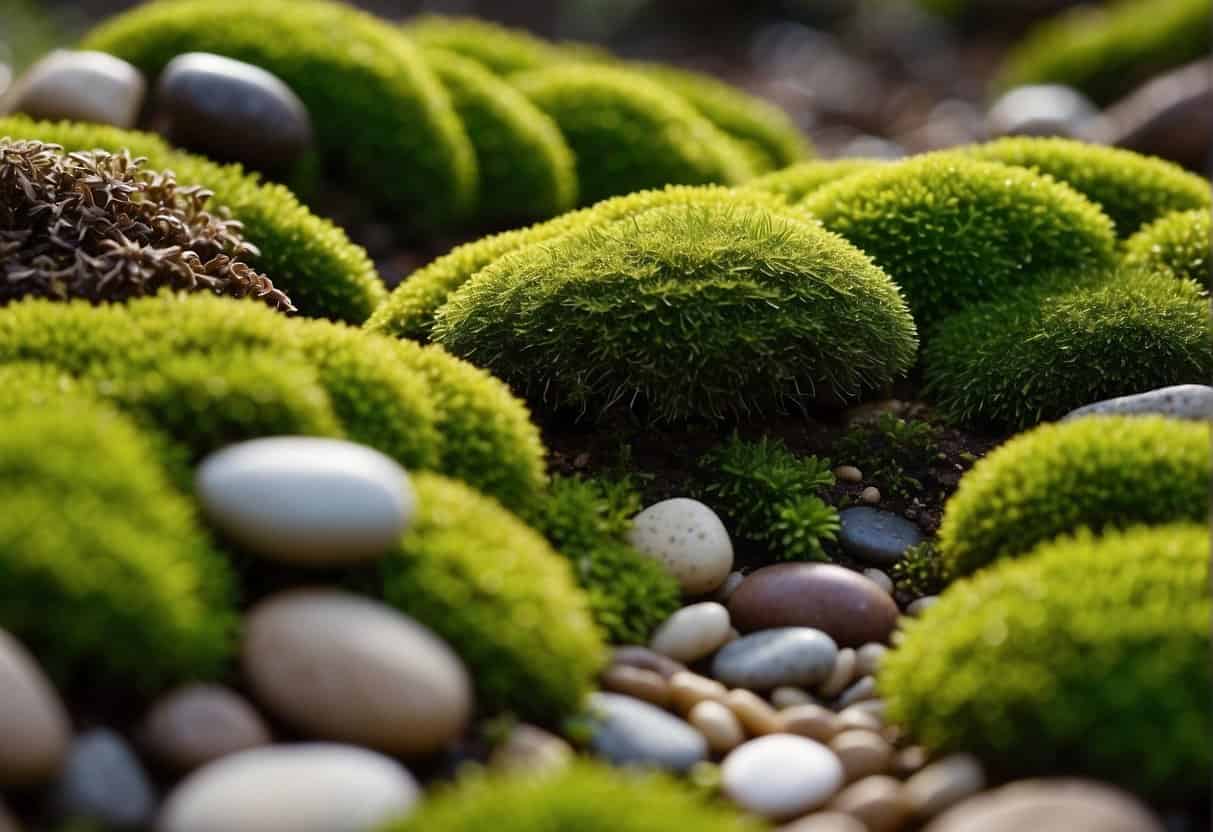
Creating the perfect terrarium ecosystem goes beyond the foundational layers of drainage, substrate, and plants. Enriching the miniature landscape with fauna, decorative nuances, and understanding their educational and therapeutic role can elevate a terrarium from simply sustaining to truly thriving.
Incorporating Fauna
Introducing fauna such as springtails or small insects contributes to a balanced ecosystem. These creatures are not only fascinating to observe but also play a vital role in the decomposition of organic matter, thus helping to maintain a healthy and clean environment for plants to flourish.
Decorative Touches
Adding decorative elements like figurines or pieces of driftwood can tell a story within your glass-encased scene. Whether it’s shaping a miniature garden fantasy or simply enhancing the aesthetic, decorative touches personalize your terrarium.
- Decorative Elements:
- Miniature figurines to craft a narrative or theme
- Driftwood or stones for natural artistry
- Carefully placed mosses to emulate landscape features

Educational and Therapeutic Benefits
Terrariums serve as an educational tool, illustrating the intricacies of ecosystems and plant care. Their maintenance and observation can have therapeutic benefits, as they provide a sense of calm and accomplishment. Engaging with a terrarium can help reduce stress and increase mindfulness.
Advanced Techniques
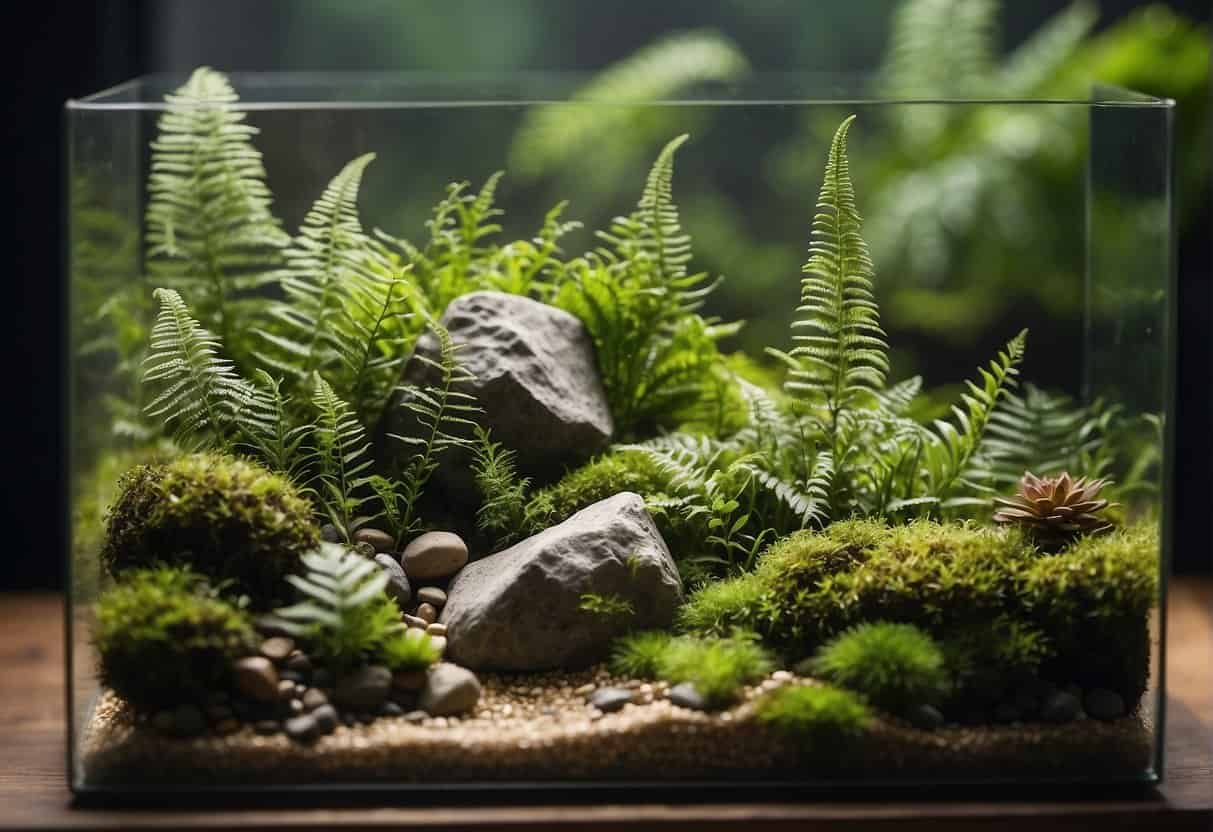
When constructing a terrarium, advanced techniques involve intricate systems that replicate a natural ecosystem. These methods increase the complexity of both closed and open terrariums, often enhancing their self-sufficiency and aesthetic value.
Integrating Advanced Features
Advanced features can be integrated into both closed and open terraria to create a more sophisticated setup. This could include adding miniature water features, installing small fans for air circulation, or using LED lights for plant growth if natural light is insufficient. For closed systems, monitoring humidity and temperature is crucial, and one may employ hygrometers and thermometers. Regular pruning and occasional watering (for open terraria) or misting (for closed terraria) ensure the plants stay healthy and do not outgrow their glass container.
Starting Your Terrarium
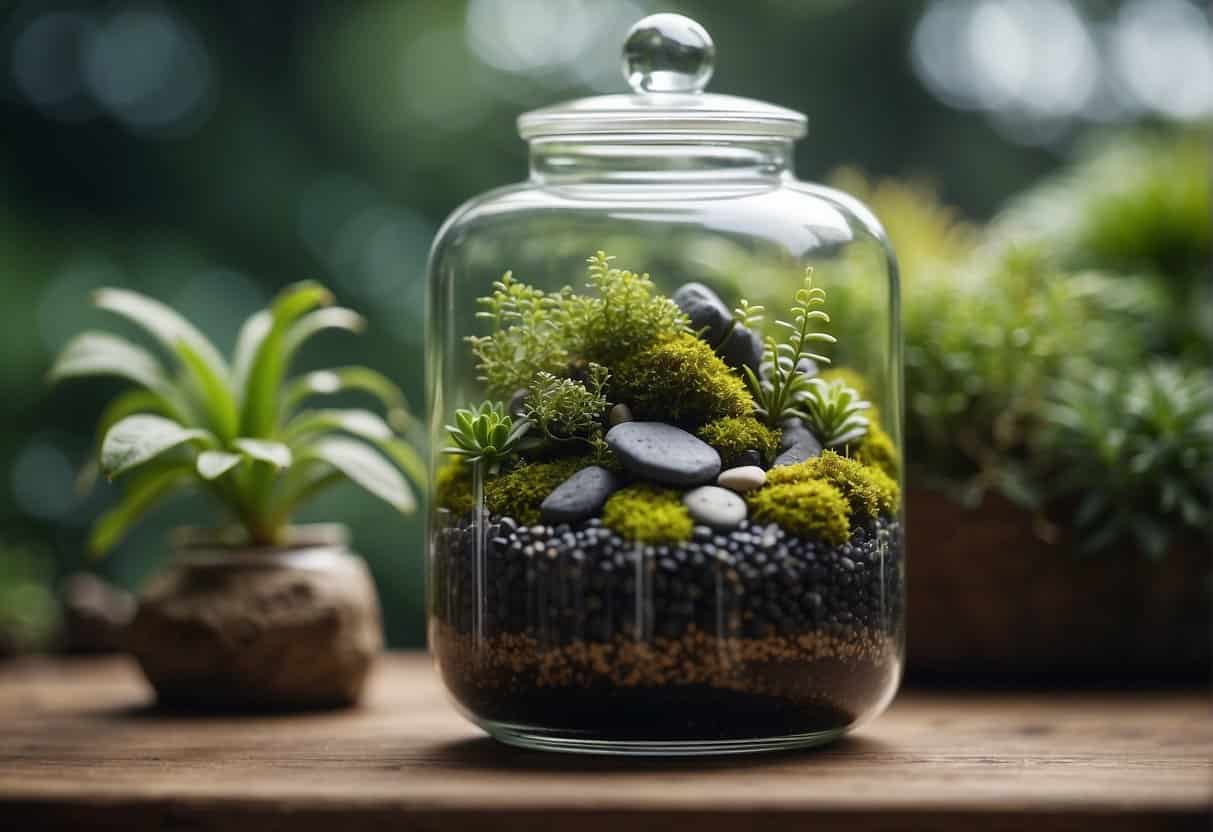
Creating a terrarium involves careful planning and specific materials. This section provides essential guidance on assembling a thriving miniature ecosystem using proper techniques and quality supplies.
Step-by-Step Guide
Building a terrarium is a rewarding venture that involves careful planning and execution. Here are the step-by-step guidelines to initiate the construction of a terrarium:
1. Begin with the Drainage Layer:
- This foundational layer is critical to prevent waterlogging and safeguard plant roots from potential rot.
- Choose materials like gravel, pebbles, or broken pot shards to facilitate efficient water drainage.
2. Add the Substrate Layer:
- The substrate layer plays a pivotal role in supporting plant growth by providing a medium for root development.
- Utilize a well-balanced mix, typically consisting of potting soil, sphagnum moss, and perlite for optimal moisture retention and aeration.
3. Integrate Decorative Elements:
- With the functional layers in place, introduce decorative elements to enhance the visual appeal of your terrarium.
- Incorporate carefully selected rocks, driftwood, or themed figurines to create a landscape that pleases the eye.
The actual assembly demands a meticulous approach. Lighting conditions should be considered when positioning the terrarium, as they greatly influence plant health. Begin by adding a drainage layer of stones or activated charcoal, then a layer of substrate, and carefully press down to create a firm base. Gently insert plants, ensuring roots are adequately covered but not compressed. Complete the layout with decorative elements, considering both the landscape and the health needs of the terrarium’s inhabitants.
By following these steps, you’ll establish a solid foundation for your terrarium, ensuring a harmonious environment for plant growth and a visually captivating display.
Selecting Quality Supplies
Choosing the right materials is paramount in terrarium construction. High-quality terrarium supplies ensure longevity and sustainability of the ecosystem. One should select substrates that provide appropriate nutrition and drainage. It’s also vital to invest in proper tools for planting, such as tweezers and long-handled shovels, which aid in the precise placement of plants and landscape features.
Creating a Closed Terrarium
A closed terrarium is a self-sustaining ecosystem within a transparent and closed container. To create one, carefully layer materials that support an autonomous water cycle. Begin with a drainage layer of pebbles or gravel, followed by activated charcoal to keep the water clean. Add a layer of sphagnum moss to prevent soil from mixing into the drainage layer. Then, layer soil appropriately for the plants you’ve chosen, typically moisture-loving ferns and mosses. The key to a thriving terrarium ecosystem is ensuring the container is sealed after planting, which allows for moisture to circulate within.
Constructing an Open Terrarium
Conversely, an open terrarium provides a home for plants that prefer less humidity, such as succulents or air plants. They require a similar initial setup involving drainage and soil layers but differ in maintenance and selection of the glass container; it must be transparent but remains unsealed. Allow for ample air flow to prevent excess moisture buildup, which can lead to plant diseases or rot.
Troubleshooting Common Issues

When maintaining a terrarium, certain issues are common but solvable. Monitoring the ecosystem and providing regular care can prevent these problems from escalating. Here is a guide to identifying and addressing common terrarium troubles effectively.
Mold and Bacteria:
If mold appears, it usually indicates excess moisture and poor air circulation. To fix mold issues, increase ventilation and reduce watering frequency. A hygrometer can help monitor humidity levels to maintain them between 50-70%.
Insects and Bugs:
Unwanted critters can be a sign of overwatering or decaying plant matter. Inspect and remove any affected foliage, and introduce natural insect control methods.
Root and Stem Health:
When roots become waterlogged or stems start to rot, reconsider the drainage system of your terrarium. A layer of gravel at the base provides better water management.
Foliage and Growth Problems:
Discolored or wilting leaves often indicate poor light conditions or nutritional deficiencies. Make sure the growth habits of each plant are suitable for a terrarium environment and adjust the light and soil composition as needed.
Watering Woes:
Overwatering is the leading cause of issues—always check the soil’s moisture before adding water. Condensation on the glass is a tell-tale sign of high humidity.
Remember, patience and observation are key to resolving terrarium troubles. Regular maintenance and quick responses to any signs of distress can keep your miniature ecosystem thriving.
Terrarium Workshops and Communities
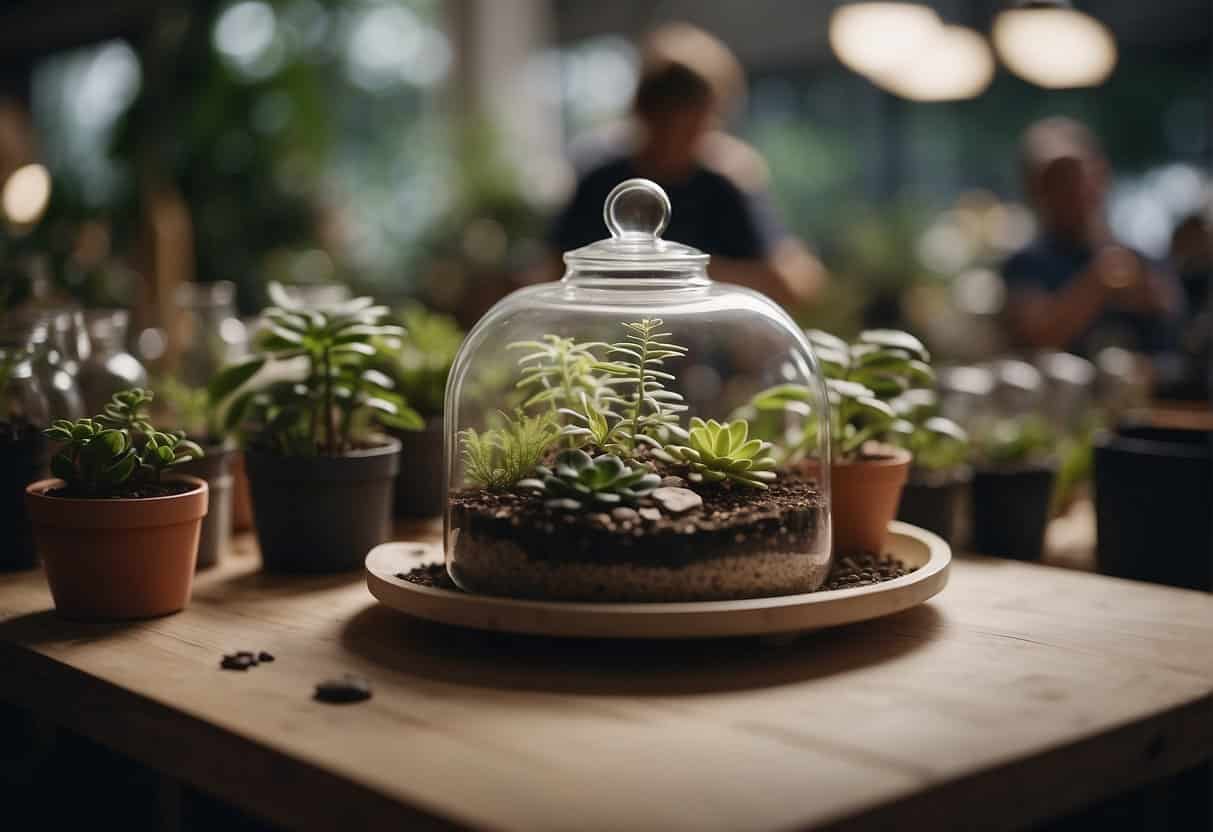
Terrarium enthusiasts often seek out workshops and communities to expand their skills and share in the joy of creating these miniature ecosystems. These gatherings serve as platforms for education and collaboration, allowing individuals to learn from experts and fellow hobbyists alike.
Educational Workshops: Participants gain hands-on experience in building terrariums, understanding the importance of each layer, and maintaining the health of their creations. Led by knowledgeable instructors, these workshops provide step-by-step guidance through the process of layering substrates, choosing suitable plants, and crafting a sustainable environment.
- Key Workshop Components:
- Soil and substrate layering
- Plant selection and care
- Moisture control and ecosystem balance
Terrarium Communities: Online forums and local clubs are treasure troves for sharing knowledge, with members ranging from beginners to seasoned experts. Community involvement not only fosters learning but also encourages the exchange of plants, materials, and inventive ideas.
- Community Benefits:
- Sharing cultivation tips and troubleshooting
- Showcasing terrarium design ideas
- Organizing group events and projects for broader community impact
Networking and Collaboration: Such communities often lead to networking opportunities. Hobbyists connect to form collaborations, ranging from group buys for rare plants to organizing larger-scale educational events.
In conclusion, terrarium workshops and communities play a significant role in enriching the terrarium-building experience. Through active participation, members can enhance their skills while contributing to a collective reservoir of knowledge.
The Future of Terrariums
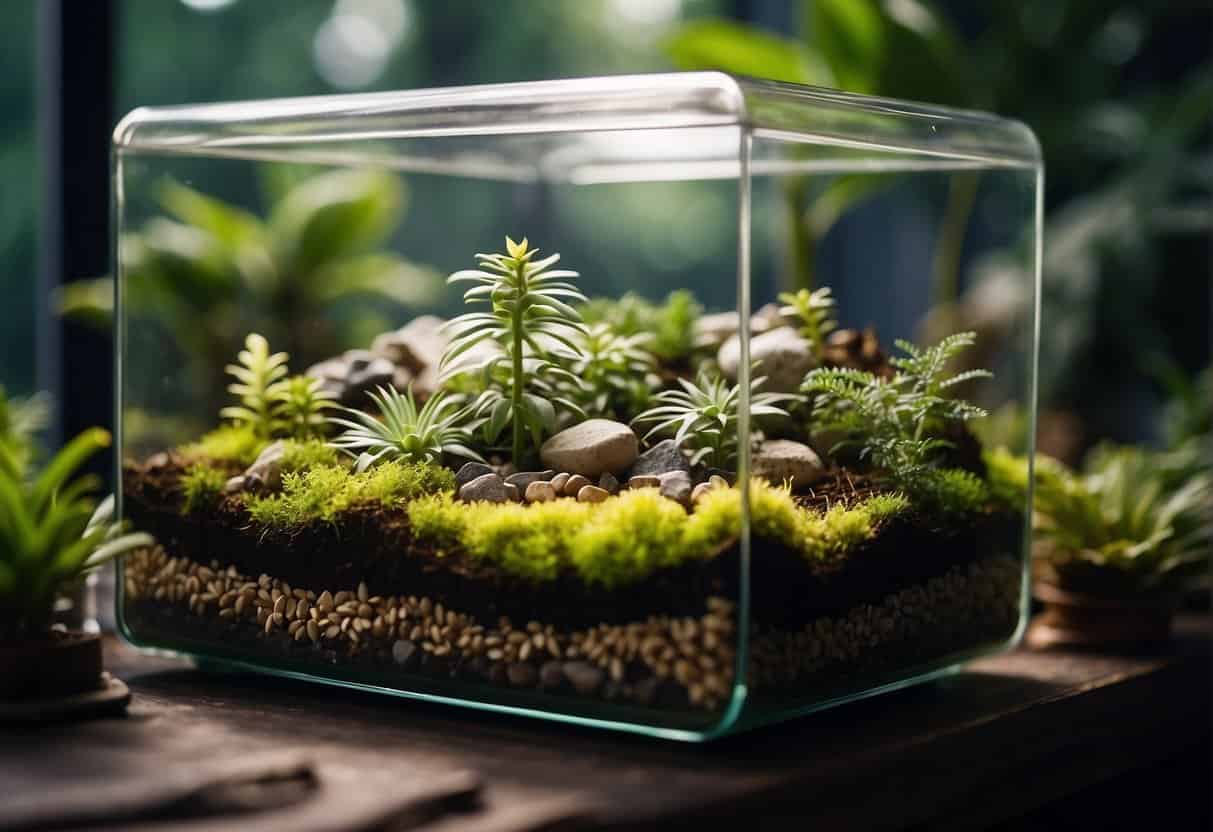
Terrariums are evolving beyond mere decorative items; they increasingly embody sustainability and environmental consciousness. With a growing emphasis on eco-friendly living, future terrariums could integrate more advanced methods of water recycling and self-sufficiency, minimizing waste and upkeep.
In terms of innovation, technological integration shows promise. The potential for app-controlled environments that maintain humidity and temperature levels is significant. This could allow for more exotic plant species to thrive in controlled micro-ecosystems.
Environmental impact is another critical area. Future terrariums may serve as educational tools, demonstrating the importance of conserving ecosystems. They may also incorporate plants that are particularly effective at filtering air, supporting urban areas with limited green space.
Trends indicate that terrariums might become interactive pieces of living art. Thoughtfully designed terrariums could double as natural air purifiers or incorporate smart sensors to involve the owner in the care process without overt intervention.
As for future developments, there is anticipation for terrariums to become part of larger green initiatives, such as integrating them into green building designs. Biophilic design principles suggest that incorporating elements of nature into our daily environment significantly benefits well-being.
Terrariums may soon interact seamlessly with smart home devices, contributing data for research on indoor plant growth patterns and improving the understanding of plant needs in varying conditions, further enhancing their value to the indoor environment.
Frequently Asked Questions
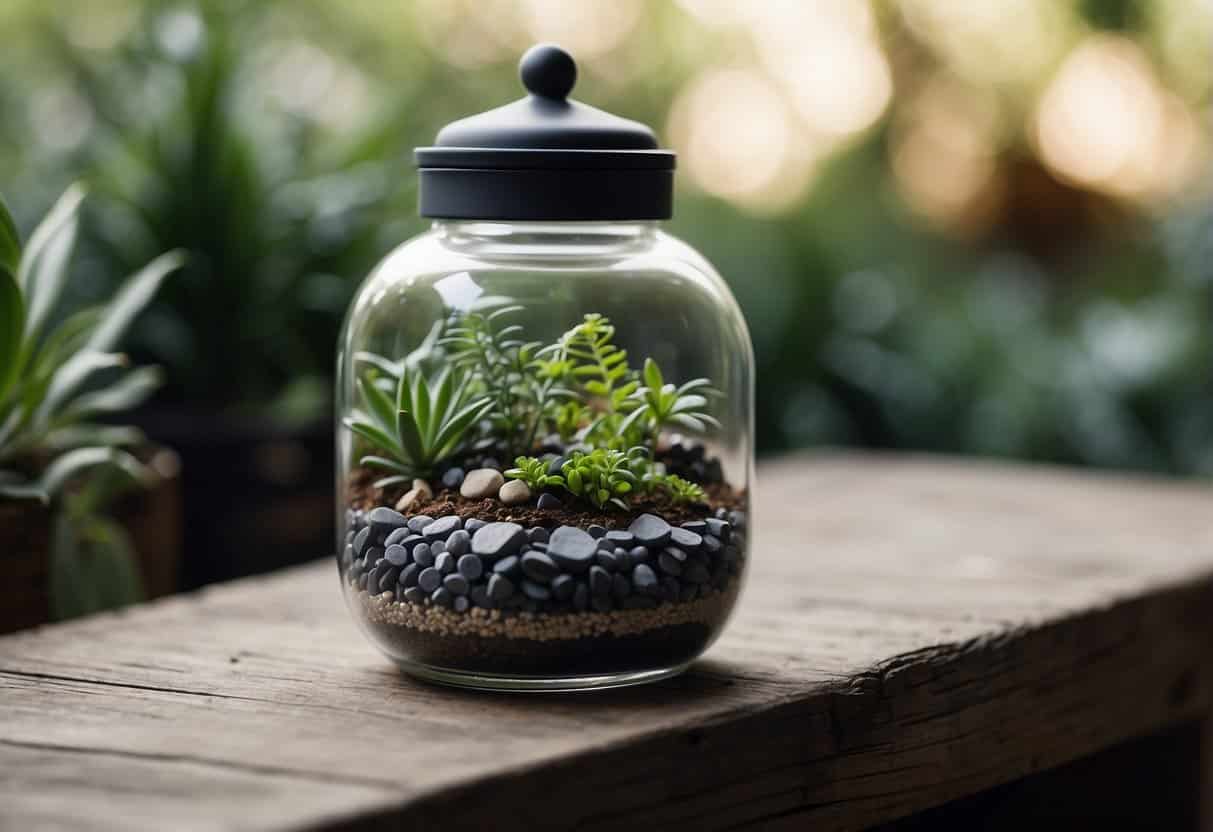
Creating a thriving terrarium requires careful selection of materials and an understanding of the ecosystem’s needs. These FAQs provide essential insights into building and maintaining a balanced terrarium environment.
What materials are needed to construct a self-sustaining terrarium?
To construct a self-sustaining terrarium, one will need a clear glass container, appropriate substrate layers, such as gravel or pebbles for drainage, activated charcoal, sphagnum moss, and potting soil. Additionally, one must select suitable plants and possibly include decorations or miniature figures for aesthetics.
Which plants are most suitable for maintaining a healthy terrarium ecosystem?
The most suitable plants for a terrarium are those that thrive in humidity and have similar light requirements. Examples include mosses, ferns, and air plants. For more detailed information, refer to guides on selecting terrarium plants.
What is the correct order of substrate layers for creating a terrarium?
The correct order of substrate layers for creating a terrarium starts with a drainage layer of gravel or pebbles, followed by a layer of activated charcoal, then a layer of sphagnum moss or a similar water-retention material, and finally, a layer of potting soil.
How can I create a mini ecosystem within a jar successfully?
To create a mini ecosystem within a jar, one must layer substrates correctly, choose plants that complement each other’s growth habits and environmental needs, and establish a balance between the water cycle and biological components. Regular monitoring and minimal maintenance will also contribute to the success of the jarred ecosystem.
Can you explain the importance of each layer in a terrarium?
Each layer in a terrarium has a distinct purpose. The drainage layer prevents root rot by keeping excess water away from plant roots. The charcoal layer filters the water and keeps the environment fresh. Sphagnum moss acts as a water retention layer, and potting soil provides essential nutrients as the primary plant growth medium.
What steps should a beginner follow to craft their first terrarium?
A beginner should follow these steps to craft their first terrarium: choose a suitable container, add a drainage layer, followed by activated charcoal, sphagnum moss, and potting soil. After arranging the substrate layers, plant the selected plants carefully, water as needed, and place the terrarium in a location with appropriate lighting conditions.


